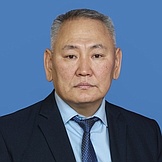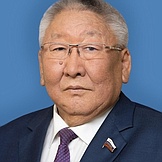Regional flags and emblems


PROFILE
Established 27 April 1922 as Yakut ASSR
Yakut SSR since 1991
Republic of Sakha (Yakutia) since 1992
Capital Yakutsk
Republic of Sakha (Yakutia) is part of the Far Eastern Federal District
Area 3083,5 sq km
Population 1 007 100 (2025)
Ethnic groups
(2020 National Census, %)
Yakut – 55,30
Russian – 32,63
Evenk – 2,87
Even (Lamut) – 1,56
Other – 6,32
Administrative divisions (2024)
Municipal districts – 34
City districts – 2
Rural towns – 48
Rural districts – 361
Geography and climate
The republic is in the north-western part of Eurasia and is the largest region of the Russian Federation. It is washed by the Laptev Sea and the Eastern Siberian Sea. The territory of the republic includes the New Siberian Islands; 40% of its area lies beyond the Arctic Circle. Mountain ranges and highlands make up the configuration of the terrain. The highest point is Peak Pobeda (3,147 m).
The maximum north-south distance is 2,000 km, while the east-west distance is 2,500 km. The republic spans three time zones.
The Sakha Republic borders on the Trans-Baikal, Krasnoyarsk and Khabarovsk territories, the Irkutsk, Magadan, Amur regions and the Chukotka Autonomous Area.
The republic’s main rivers are the Lena, the Yana, the Indigirka, and the Kolyma. There are also over 700,000 lakes.
The climate varies from sharply continental in the south to subarctic and polar in the north. January temperatures average –39.4°C, July temperatures average +15.1°C. Mean precipitation in January is 11 mm, while mean precipitation in July is 57 mm. The vegetation period in the south is between 120 and 130 days, in the north – between 60 and 90 days. All of the territory is covered by permafrost. The republic is one of the world’s most isolated and hard to access regions in respect of transportation: 90% of its area has no year-round transport connections.
There are also two State Nature Reserves, Olyokma and Lena Delta, and more than 120 protected areas of regional significance and more than 100 areas are local significance.
Government
The legislative branch in the Republic of Sakha (Yakutia) is represented by the State Assembly (Il Tumen) of the Republic of Sakha (Yakutia) – the Parliament of Republic of Sakha (Yakutia), which is representative legislative and monitoring authority in the republic.
The State Assembly (Il Tumen) has 70 deputies elected for five years. 35 of them run in single member constituencies and the other 35 in the single republican electoral district in proportion to the number of votes cast for lists of candidates nominated by electoral associations.
The current State Assembly (Il Tumen) was elected in September 2023. Its term expires in September 2028.
The Head of the Republic of Sakha (Yakutia) is the region’s highest-ranking official and the head of the republic’s executive branch of government. He is elected for five years by Russian citizens who permanently reside in the region. The term of office of the current incumbent expires in September 2028.
The executive branch in the Republic of Sakha (Yakutia) is represented by the Government of the Republic of Sakha (Yakutia), the republic’s supreme body of executive authority. The Government of the Republic of Sakha (Yakutia) is accountable and reports to the Head of the Republic of Sakha (Yakutia). The Head of the republic appoints the Prime Minister of the Republic of Sakha (Yakutia) and his/her deputies with the approval by the State Assembly (Il Tumen).
Economy and natural resources
The Republic of Sakha (Yakutia) is one of Russia’s most important regions in the sphere of mineral resources and mining. Yakutia is Russia’s leading region in terms of the total amount of all types of natural resources it possesses.
Industrial manufacturing accounts for over 60% of the regional GDP. Mineral production is based on proved deposits of diamonds, gold, coal, iron ore, tin, antimony, zinc, lead, tungsten, silver, mercury, uranium, natural gas, oil and condensates. The main diamond mining enterprise in the republic is ALROSSA and its subsidiaries. The systemic companies of the coal mining industry are Yakutskugol, Kolmar, and Zyryansky Ugolny Razrez. The largest companies in the oil and gas industry are Surgutneftegaz, Taas-Yuryakh Neftegazdobycha, YATEK, ALROSA-Gas, Lensk-Gas, and Sakhatransneftegas.
Manufacturing is represented by production of construction materials, lapidary and jewellery companies, pharmaceuticals, as well as the light and food industries.
The basis for the production and distribution of electricity, gas and water in the republic is the local energy complex represented by thermal power plants and stations.
Agriculture is represented by the following spheres, traditional for the local population: meat and dairy cattle farming, horse herd farming, deer breeding and crop farming. Hunting, fur trapping, fishing, and caged-animal farming are also developed in the northern parts of the republic.
The republic is located in an area of high-risk farming with harsh natural and climatic conditions, poor infrastructure, limited accessibility to the territories and the dispersion and remoteness of agricultural suppliers from large market outlets.
Culture and tourism
Yakutia is full of natural contrasts. It is perfect for those who are attracted by the romance of travelling: it is a land of dense taiga forests and vast tundra spaces, fierce mountain ranges and icy Arctic expanses, authentic culture and kind, warm-hearted people whose warmth and hospitality you can feel from the very first days in Yakutia.
Yakutia was first inhabited in the Lower Paleolithic Age, and archaeologists have found artefacts on its territory that date back to the period from 300,000 to 3 million years ago, such as the Lower Paleolithic site called Diring Yuriakh. In the middle of the first millennium AD Yakutia was populated by the ancestors of Evens and Evenks, and by the 13th century the middle Lena, the Vilyuy, and the Olyokma regions became inhabited by Tungusic and Yakut tribes.
The republic is famous for its unique museums that cannot be found in other places, among which the Museum of the Cultural History of the Peoples of the North, the Mammoth Museum, the Museum of the History of the Study of Permafrost, the Museum and Khomus Center of the Peoples of the World, etc.
One of the main tourist attractions is the Lena Pillars Nature Park. This unique natural phenomenon is located at the very shore of the great river Lena. The fanciful shapes of pillars are reminiscent of colonnades, towers, arcs, cathedrals and castellation walls. Numerous rare animal and plant species are present on the park territory. It also contains fossils of prehistoric animals, such as mammoths, bisons and others.
The locality of Oymyakon, which is situated in the republic, is considered to be the Northern Pole of Cold where the lowest temperature (-71.2С°) ever in an inhabited place was recorded. The legendary Labynkyr Lake is also located there. It is famous for its legends, which say that northern dinosaurs inhabit this lake, the likes of the Loch Ness Monster.
One more tourist attraction is the Permafrost Kingdom, which is a huge ice cave decorated by a team of professional ice sculptors. In winter, when its −50 С° outside, the temperature inside the cave does not get lower than –10 С°, while in the summer heat it only rises up to –4С°.
_________________________________________________________________


